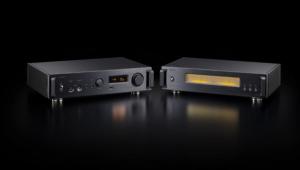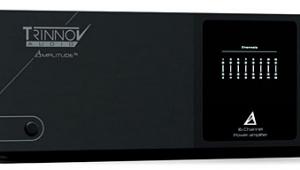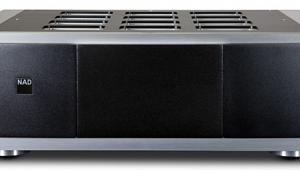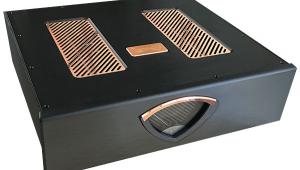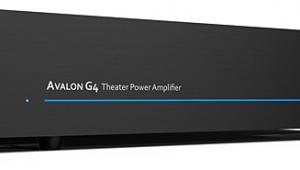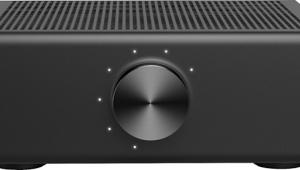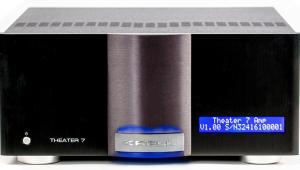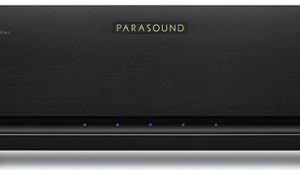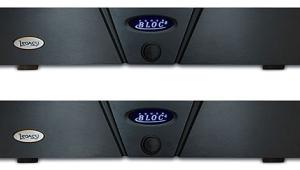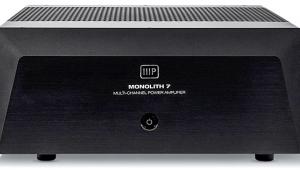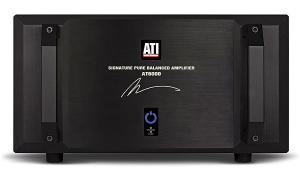Krell Home Theater Standard 2 & Theater Amplifier Standard pre-pro and 5-channel amp Page 2
The Home Theater Standard 2 offers an unprecedented number of highly usable music and movie modes. My favorite was Preamp, which allowed me to send the signal from my analog turntable and phono stage through the HTS2 without it ever being converted to the digital domain, with the left and right speakers driven full range, without the subwoofer. Unlike Preamp, the Stereo mode operates in the digital domain, so it's the perfect choice for CD or other digital sources. Passing an analog input through Stereo will force the processor to first convert it to a digital signal. As good as Krell's 20-bit A/D converters are, the best conversion is no conversion at all.

The Pro Logic mode worked better than Stereo with television broadcasts and even with DVD supplemental material, which is often recorded as a 2.0 stereo signal. Watching Hannibal's supplementary disc and switching from Stereo to Pro Logic spread Hans Zimmer's haunting yet beautiful soundtrack around the room while keeping voices focused at center screen.
Dolby Digital and DTS modes are automatically selected when detected, with a minor exception: When a DTS movie ends, the processor doesn't automatically switch back to Dolby Digital when the DVD's main menu appears. Selecting any other input and then returning to DVD is one simple cure. Going to bed is another.
The HTS2 includes nine additional surround modes. Four of them—On Stage, Orchestra, Mezzanine, and Party—use all six channels. The best was On Stage; the opening bars of Paavo Järvi and the Cincinnati Symphony's great new recording of Berlioz's Symphonie Fantastique (Telarc CD-80578) benefited with increased separation between the first and second violins. Most blues and rock recordings also sounded really good through On Stage. Listening to Dave Mason's slide guitar and Eric Clapton's picking on the 30-year-old recording of "Coming Home," from Best of Delaney & Bonnie (AAD CD, Rhino R2 70777), it was all too easy to prefer the multichanneled On Stage matrix to the original, for its sense of liveliness and immediacy. On Stage provided an increased sense of ambience and focus, with greater separation of instruments. The center channel and rear surrounds never identified themselves as such, indicating a very sensible blending of all channels. Most stereo recordings came away sounding as if they'd been originally recorded and mixed in a 5.1-channel format by someone with taste. How's that for a change of pace?
I found the Mezzanine mode too reverberant for most recordings, but Orchestra was subtle enough to improve some live releases. I compared the multichannel DTS version of the Allman Brothers' At Fillmore East (HDS, 710215-4410-2-3) to the reworked 2-channel version, The Fillmore Concerts (CD, Polydor 314 517 294-2). In Orchestra mode the Krell was able to build a more realistic, stage-biased concert venue than the guitars-in-the-back DTS release, despite the DTS tracks' otherwise deep noise floor and lack of compression artifacts.
Enhanced Stereo forgoes the rear channels but runs the sub and center. And in case your main speakers are bass-shy, Full Range + Sub pushes a full-range signal through your main speaker while simultaneously sending everything below 80Hz to the subwoofer.
One limitation is that there are only two selection buttons on the remote and front panel for all of these music modes. You can program in your favorites, but to select any of the others you'll have to fire up your video display and go digging through some menus.
Getting back to Hannibal . . . that Hans Zimmer snippet at the beginning of chapter 17 features an aria intended to simulate an opera inspired by Dante. It may be a fake, but hell's bells, it's good. Finally, we can banish from all further home-theater demos The Fifth Element's Blue Diva scene! The disc contains both DTS and Dolby Digital soundtracks; I compared them and found DTS more richly rewarding, with a warmer presentation more appropriate to the material. But regardless of which I preferred, the clarity of the HTS2's circuits was the unabashed winner here, bringing me Florence at night and the marvelous reflections of the piazzas.
Nothing is perfect, and I did encounter a few nits in the knitting. Besides the DTS-to-DD glitch already mentioned, the HTS2 lopped off the first few seconds of track 1 of any CD. It wasn't an issue of the Krell not locking on to the digital signal off my DVD player in time, as is frequently the case—I could faintly hear those few seconds of music, albeit at "mute" level. If you have this problem, just hit the skip-back button. [I have experienced a similar characteristic with a number of other processors. If DTS material is played back without DTS decoding, it can cause a loud burst of noise; this delay allows the processor to analyze the input signal and ensure that DTS processing is switched in, if appropriate.—TJN]
With movies, the HTS2 proved extremely dynamic and, for lack of a better word, clean. No matter how subtle—or, in the case of Howard Shore's music for David Cronenberg's eXistenz (DVD, Dimension 1936), how creepy—the soundtrack, the HTS2 sounded as if it was bringing everything to the fore while never squelching the soundtrack's sense of depth. Cronenberg's tricks include modifying and mixing the sounds of many of his virtual-reality creatures into the background to serve as crickets during the many night scenes. Without leaning into the sound, the HTS2 exposed these creatures of the night as obvious frauds—a fact that only contributed to the eeriness of this little-known but must-see sci-fi gem.
Director John Woo's Mission: Impossible 2 is an action movie beyond reproach, though the original of a few years before surpasses it for intrigue. But there was no arguing with the commercial airliner—screaming white noise—that passes across the screen at least twice in the opening segment. That segment exercised my system's grip on dynamics across the entire frequency spectrum. When my wife, Gina, asked me to turn it down because "it hurts," I knew the HTS2 was doing its part to convey Woo's intentions.
A half hour into the movie, as Tom Cruise and Thandie Newton question each other's motives by candlelight on their hotel room's veranda, crowd noise and distant fireworks blended with Spanish guitar and those ubiquitous crickets to draw me into the fantasy. It was very easy to lose myself in a dream world with the HTS2 in control.
[One additional note: FM was unable to check the transparency of the Krell's video switching with a high-def source. I did, and found that viewed on the very sharp Fujitsu 50-inch plasma (review in progress) it performed superbly.—TJNs]
- Log in or register to post comments
